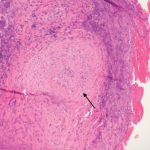 Payam Pourhassani, DO, MSc, is a third-year internal medicine resident at Drexel University College of Medicine, Philadelphia. He received his medical degree from Philadelphia College of Osteopathic Medicine.
Payam Pourhassani, DO, MSc, is a third-year internal medicine resident at Drexel University College of Medicine, Philadelphia. He received his medical degree from Philadelphia College of Osteopathic Medicine.
 Sneha N. Patel, MD, is an internal medicine resident at Drexel University College of Medicine/Hahnemann University Hospital in Philadelphia. She received her medical degree from St. George’s University in 2015.
Sneha N. Patel, MD, is an internal medicine resident at Drexel University College of Medicine/Hahnemann University Hospital in Philadelphia. She received her medical degree from St. George’s University in 2015.
ad goes here:advert-1
ADVERTISEMENT
SCROLL TO CONTINUE
 Arundathi Jayatilleke, MD, is the program director of the Drexel Rheumatology Fellowship at Drexel University. Dr. Jayatilleke completed her internal medicine residency at New York Presbyterian Hospital and her rheumatology fellowship at the Hospital for Special Surgery.
Arundathi Jayatilleke, MD, is the program director of the Drexel Rheumatology Fellowship at Drexel University. Dr. Jayatilleke completed her internal medicine residency at New York Presbyterian Hospital and her rheumatology fellowship at the Hospital for Special Surgery.
References
- Lara AR, Schwarz MI. Diffuse alveolar hemorrhage. Chest. 2010 May;137(5):1164–1171.
- Bosch X, Guilabert A, Font J. Antineutrophil cytoplasmic antibodies. Lancet. 2006 Jul 29;368(9533):404–418.
- Kallenberg CG. Key advances in the clinical approach to ANCA-associated vasculitis. Nat Rev Rheumatol. 2014 Aug;10(8):484–493.
- Lee RW, D’Cruz DP. Pulmonary renal vasculitis syndromes. Autoimmun Rev. 2010 Aug;9(10):657–660.
- Kimmel M, Braun N, Alscher MD. “Differential diagnosis of the pulmonary-renal syndrome.” An Update on Glomerulopathies—Clinical and Treatment Aspects (Prabhakar S, ed.). Rijeka, Croatia: InTech, 2011 Nov.
- Pusey CD. Anti-glomerular basement membrane disease. Kidney Int. 2003 Oct;64(4):1535–1550.
- Saxena R, Bygren P, Arvastson B, Wieslander J. Circulating autoantibodies as serological markers in the differential diagnosis of pulmonary renal syndrome. J Intern Med. 1995 Aug;238(2):143–152.
- Holle JU, Gross WL. Treatment of ANCA-associated vasculitides (AAV). Autoimmun Rev. 2013;12(4):483–486.
- Geetha D, Kallenberg C, Stone JH, et al. Current therapy of granulomatosis with polyangiitis and microscopic polyangiitis: The role of rituximab. J Nephrol. 2015 Feb;28(1):17–27.


